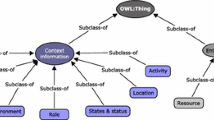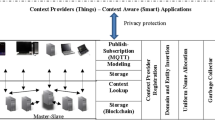Abstract
In pervasive environments, context management systems are expected to administrate large volume of contextual information that is captured from spatial to nonspatial elements. Research in context-aware computing produced a number of middleware systems for context management to intermediate the communications between applications and context providers. In particular, in pervasive environments, the design of distributed storage, retrieval and propagation mechanisms of context information across domains is vital. In this paper, we propose a domain-based approach to address the requirements of scalable distributed context management, cross-domain efficient context information dissemination and domain-based privacy policy enforcement. We propose infinitum, a middleware architecture that incorporates the management and communication benefits of the Google Wave Federation Protocol, while also taking advantage of the semantic and inference benefits of ontology-based context models. This architecture establishes a robust cross-domain scalable context management and collaboration framework, which has been implemented and evaluated in a real-life application of “SMART University” to support virtual team collaboration.







Similar content being viewed by others
References
Weiser M (1991) The computer for the 21st century. Mob Comput Commun Rev 3(3):3–11
Baldauf M, Dustdar S, Rosenberg F (2007) A survey on context-aware systems. Int J Ad Hoc Ubiquitous Comput 2(4):263–277
da Rocha RCA (2009) Context management for distributed and dynamic context-aware computing. PhD Thesis
Jaroucheh Z, Liu X, Smith S (2010) Recognize contextual situation in pervasive environments using process mining techniques. J Ambient Intell Humaniz Comput 2:53–69
Valla M, Goix LW, Criminisi C, Bauer M, Kovacs E, Ito N, Schülke A (2010) The context API in the OMA next generation service interface. In: Proceedings of ICIN 2010
Dey AK, Abowd GD, Salber D (2001) A conceptual framework and a toolkit for supporting the rapid prototyping of context-aware applications. Hum-Comput Interact 16:97–166
Román M, Hess C, Cerqueira R, Campbell RH (2002) A middleware infrastructure for active spaces. IEEE Pervasive Comput 1(4):74–83
Hong JI, Landay JA (2004) Architecture for privacy-sensitive ubiquitous computing. In: Proceedings of 2nd international conference on mobile systems, applications, and services, Boston, MA, USA, pp 177–189
Henricksen K, Indulska J, McFadden T, Balasubramaniam S (2005) Middleware for distributed context-aware systems. In: Meersman R, Tari Z (eds) On the move to meaningful internet systems 2005: CoopIS, DOA. Proceedings of the OTM confederated international conferences: CoopIS, DOA and ODBASE 2005, part 1. Agia Napa, Cyprus. Springer, pp 846–863
Kiani SL, Riaz M, Lee S, Lee Y-K (2005) Context awareness in large scale ubiquitous environments with a service oriented distributed middleware approach. In: Proceedings of fourth annual acis international conference on computer and information science (ICIS’05), pp 513–518
Grossmann M, Bauer M, Hönle N, Käppeler U-P, Nicklas D, Schwarz T (2005) Efficiently managing context information for large-scale scenarios. In: Proceedings of the third IEEE international conference on pervasive computing and communications. IEEE Computer Society, pp 331–340
Roussaki I, Strimpakou M, Pils C, Kalatzis N, Liampotis N (2009) Distributed context management in support of multiple remote users. In: Context-aware mobile and ubiquitous computing for enhanced usability. IGI Publishing Hershey, PA, pp 84–113. ISBN: 1605662909, 9781605662909
Dearle A, Kirby G, Morrison R, McCarthy A, Mullen K, Yang Y, Connor R, Welen P, Wilson A (2003) Architectural support for global smart spaces. In: Lecture notes in computer science; vol 2574, Proceedings of the 4th international conference on mobile data management. Springer, pp 153–164
Chen G, Li M, Kotz D (2008) Data-centric middleware for context-aware pervasive computing. Pervasive Mob Comput 4:216–253
Lee D, Meier R (2009) A hybrid approach to context modelling in large-scale pervasive computing environments. In: Proceedings of the fourth international icst conference on communication system software and middleware—COMSWARE’09, p 1
Strohbach M, Bauer M, Kovacs E, Villalonga C, Richter N (2007) Context Sessions—A novel approach for scalable context management in NGN networks, MNCNA’07 proceedings of the 2007 workshop on middleware for next-generation converged networks and applications, pp 1–6
Floreen P, Przybilski M, Nurmi P, Koolwaaij J, Tarlano A, Wagner M, Luther M, Bataille F, Boussard M, Mrohs B, Lau S (2005) Towards a context management framework for mobilife. In: Proceedings of the IST mobile and wireless communications summit
Klemettinen M (2007) Enabling technologies for mobile services: the MobiLife book. Wiley, London. ISBN: 0470512903, 9780470512906
Percivall G, Reed C, Davidson J (2007) Open geospatial consortium Inc. OGC white paper OGC® sensor web enablement: overview and high level architecture
Castelli G, Zambonelli F (2009) Contextual data management and retrieval: a self-organized approach. In: Proceedings of 2009 IEEE/WIC/ACM international conference on web intelligence and intelligent agent technology, pp 535–538
Mehrotra A (1997) GSM system engineering, mobile communications series. Artech House, Inc., Norwood. ISBN: 0890068607
Chen H, Finin T, Joshi A (2004) An ontology for context-aware pervasive computing environments. Knowl Eng Rev 18:197–207
Wang XH, Gu T, Zhang DQ, Pung HK (2004) Ontology based context modeling and reasoning using OWL. In: Proceedings of the second IEEE annual conference on pervasive computing and communications workshops. IEEE Computer Society, Washington, DC, pp 18–22. ISBN: 0-7695-2106-1
Reignier P, Brdiczka O, Vaufreydaz D, Crowley JL, Maisonnasse J (2007) Context-aware environments: from specification to implementation. Expert Syst 24:305–320
Gu T, Wang XH, Pung HK, Zhang DQ (2004) An ontology-based context model in intelligent environments. In: Proceedings of communication networks and distributed systems modeling and simulation conference
Gu T, Pung HK, Zhang DQ (2004) A middleware for building context-aware mobile services. In: Proceedings of the IEEE 59th vehicular technology conference. IEEE Computer Society, pp 2656–2660
Google (2009) Google wave federation protocol : white papers. http://www.waveprotocol.org
Google (2009) Wave in a box. http://www.waveprotocol.org/code
XMPP (2004) XMPP Standards Foundation. http://www.xmpp.org/
OpenFire (2010) OpenFire server. http://www.igniterealtime.org/projects/openfire/index.jsp
Jena2 Semantic Web Toolkit (2010) http://jena.sourceforge.net
Arduino (2010) Arduino. http://www.arduino.cc/
Author information
Authors and Affiliations
Corresponding author
Rights and permissions
About this article
Cite this article
Jaroucheh, Z., Liu, X. & Smith, S. An approach to domain-based scalable context management architecture in pervasive environments. Pers Ubiquit Comput 16, 741–755 (2012). https://doi.org/10.1007/s00779-011-0422-0
Received:
Accepted:
Published:
Issue Date:
DOI: https://doi.org/10.1007/s00779-011-0422-0




